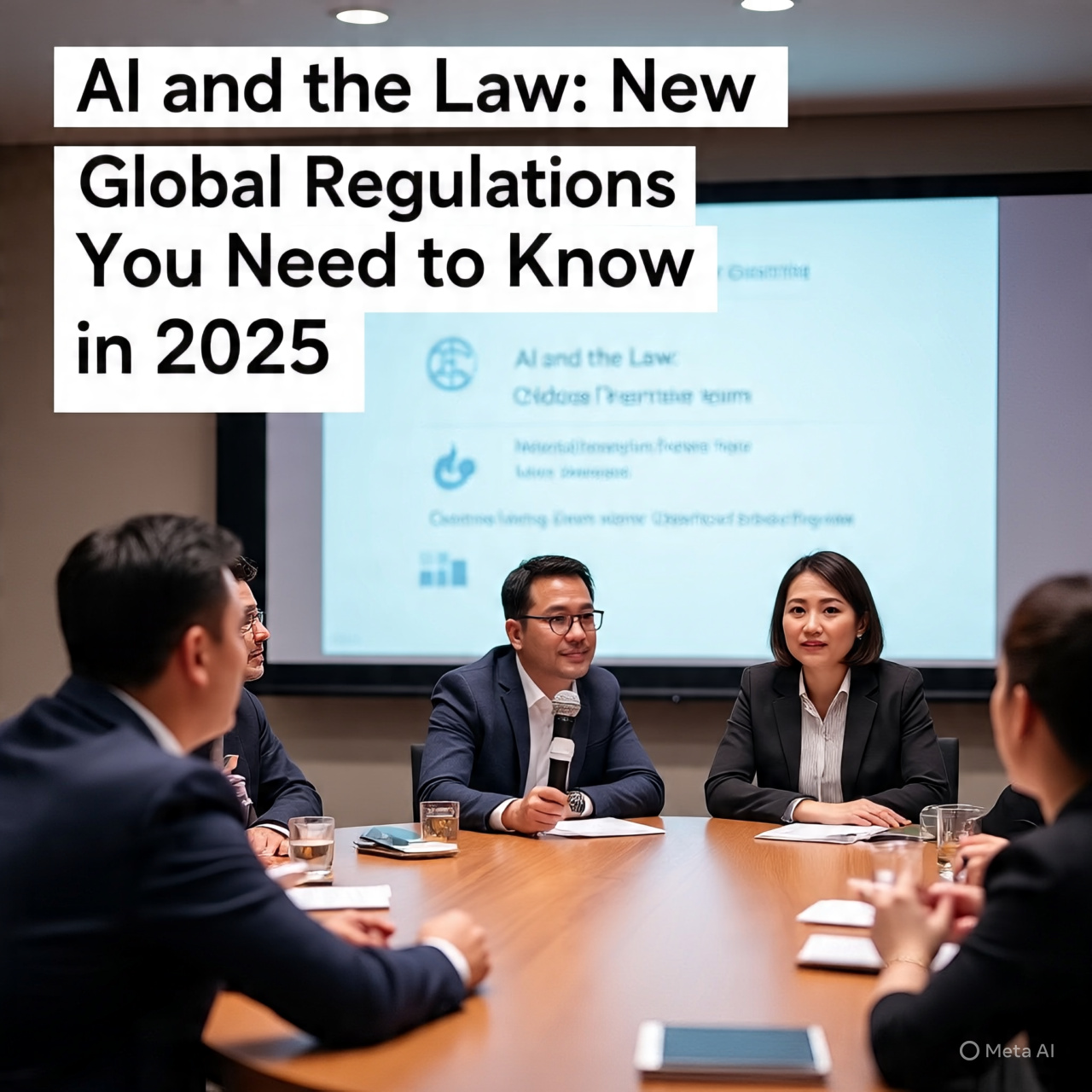Introduction
Artificial Intelligence (AI) is no longer a futuristic concept—it’s now a core part of our daily lives, from voice assistants and autonomous vehicles to predictive policing and legal research tools. As AI’s power grows, so does the urgency to regulate it. That’s why “AI and the Law: New Global Regulations You Need to Know in 2025” is not just a buzzworthy topic; it’s a vital one.
In 2025, countries worldwide are ramping up their regulatory efforts to keep pace with AI advancements. Whether you’re a tech entrepreneur, developer, legal expert, or simply an informed citizen, understanding the global legal landscape around AI is essential. This article breaks it all down—highlighting new laws, comparing global strategies, and offering insights on how to stay compliant and competitive.
Background: Why Regulating AI Is More Critical Than Ever
AI is powerful—but with great power comes great legal complexity. Over the past few years, AI has been implicated in:
- Bias and discrimination (e.g., in hiring algorithms or facial recognition)
- Data privacy violations
- Deepfake and misinformation campaigns
- Autonomous decisions with legal consequences
Governments and organizations realized that without a strong legal framework, AI could deepen inequality, undermine democracy, and erode trust. That realization has brought us to 2025, a pivotal year for AI regulation on a global scale.
Global Comparison of AI Laws in 2025
Major Players and Their Approach
Below is a comparison table summarizing key aspects of AI regulation in various regions:
| Region | Key Legislation | Focus Areas | Enforcement Body |
|---|---|---|---|
| European Union | EU AI Act (Effective 2025) | Risk-based AI classification, transparency, biometric surveillance | European AI Board |
| United States | AI Accountability Act (2025) | Corporate transparency, algorithmic audits, civil rights protection | Federal Trade Commission (FTC) |
| China | Algorithm Regulation Law (2024, expanded 2025) | Content moderation, social harmony, state control of AI use | Cyberspace Administration of China |
| Canada | Artificial Intelligence and Data Act (AIDA) | Responsible AI deployment, public trust, innovation safety | Office of the Privacy Commissioner |
| United Kingdom | Pro-innovation AI Regulation Framework (2025) | Sector-specific regulation, soft guidance over hard rules | Various sectoral regulators (ICO, CMA) |
Key Takeaway
Each region’s approach reflects its values—the EU prioritizes safety and rights, the US focuses on corporate responsibility, and China leans into control and content regulation. This diversity poses challenges for multinational companies navigating compliance across jurisdictions.
Key Features of 2025 AI Laws
1. Risk-Based Regulation
Especially prominent in the EU AI Act, this approach categorizes AI systems by the level of risk they pose:
- Unacceptable risk: Prohibited (e.g., social scoring)
- High-risk: Strictly regulated (e.g., medical AI)
- Limited risk: Transparency obligations (e.g., chatbots)
- Minimal risk: Light or no regulation
2. Transparency Requirements
Most countries now require that AI systems clearly disclose when users are interacting with a machine, especially in high-stakes scenarios like recruitment or public services.
3. Algorithmic Auditing & Accountability
Firms must conduct regular AI audits, documenting data usage, decision logic, and potential bias. The U.S. AI Accountability Act mandates independent third-party audits for high-impact applications.
4. AI Ethics & Human Oversight
AI should never act as the sole decision-maker in areas like legal judgments, medical treatments, or criminal sentencing. Most new laws demand “human-in-the-loop” oversight.
5. Global Registries & Licensing
Some jurisdictions are creating central AI registries where high-risk models must be registered and potentially licensed (similar to the EU AI Board’s approach).
Pros and Cons of Global AI Regulation
✅ Pros
- Protects human rights and civil liberties
- Encourages trustworthy innovation
- Reduces bias and discrimination
- Boosts consumer trust
- Levels the playing field for startups
❌ Cons
- Complexity for multinational compliance
- Slows down rapid innovation
- Potential regulatory overreach
- Varying definitions of AI make harmonization difficult
Who Needs to Pay Attention?
These regulations impact a wide range of stakeholders:
| Group | Why It Matters |
|---|---|
| Tech Startups | Must ensure compliance early to avoid penalties and attract investors |
| Large Enterprises | Must implement AI governance frameworks across borders |
| Developers | Need to understand transparency and audit requirements |
| Legal Teams | Play a crucial role in policy mapping and enforcement |
| Policymakers | Use this landscape to refine their own AI regulations |
| Consumers | Can better understand their rights and responsibilities |
Real-World Use Cases
Healthcare AI in the EU
A German startup using AI to detect skin cancer had to undergo a risk assessment, register with the EU AI Board, and submit to annual audits. The outcome? Increased trust from both patients and investors.
Hiring Algorithms in the US
A Fortune 500 company using an AI résumé screener was fined in 2025 after it was found to discriminate against older applicants. Thanks to the AI Accountability Act, the system had to be redesigned and audited.
Social Media Filtering in China
A Chinese company deploying AI to filter politically sensitive content must comply with new algorithm filing requirements and disclosure mandates or risk shutdown.
FAQs About AI and the Law in 2025
1. What is the EU AI Act and when does it take effect?
The EU AI Act is a groundbreaking piece of legislation that classifies AI systems by risk. It officially took effect in 2025 and enforces strict rules on high-risk systems, including registration, transparency, and human oversight.
2. Is the U.S. banning any types of AI?
No bans yet, but the U.S. focuses on accountability and transparency. The AI Accountability Act doesn’t ban AI, but mandates independent audits and public disclosures for high-impact use.
3. How can companies stay compliant with global AI laws?
Implement internal AI governance, conduct regular algorithmic audits, document model training, and appoint AI compliance officers familiar with laws across regions.
4. What’s the penalty for violating AI laws in 2025?
Penalties vary. In the EU, companies can face fines up to €30 million or 6% of global revenue, while U.S. fines can include multi-million-dollar penalties and lawsuits for civil rights violations.
5. Are there any global standards for AI regulation?
Not yet. However, initiatives like the OECD AI Principles and G7 Hiroshima AI Process aim to harmonize approaches and promote responsible innovation globally.
Conclusion: Regulation Is Not the Enemy of Innovation
If you’re in the AI space, don’t fear regulation—embrace it as a framework for responsible growth. With clear rules, companies gain legitimacy, customers feel safe, and innovation flourishes ethically.
AI regulations in 2025 are more than just red tape—they’re building the foundation for a future where machines and humans coexist in fairness, trust, and safety.
Final Verdict: What Should You Do Now?
Whether you’re building, deploying, or interacting with AI, here’s your 2025 action plan:
- Audit your AI systems regularly
- Stay informed on regional compliance requirements
- **Join industry forums and legal brief

